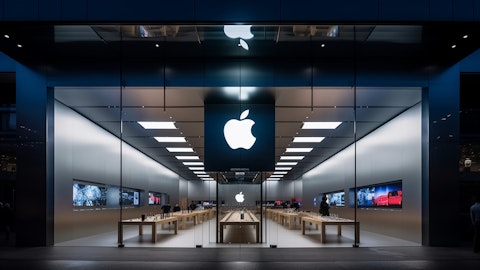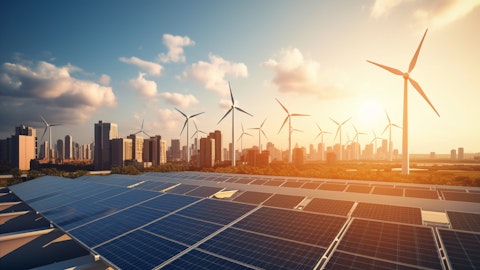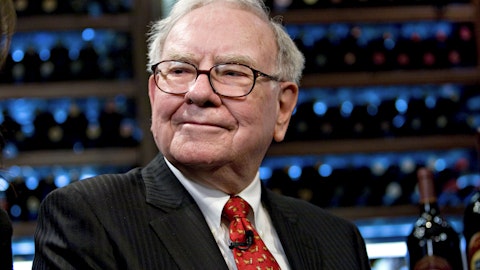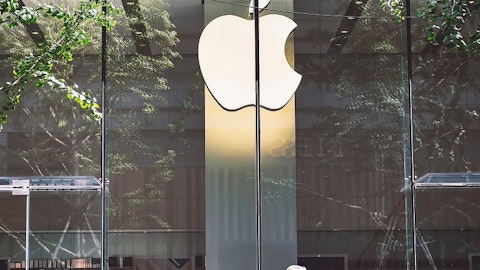Luca Maestri: On the margin side, if I understood your question correctly about the December quarter guidance, keep in mind that actually December is the quarter where our products business is tends to be very heavy because of the holiday season. And so the services gross margins that are accretive to total company had an impact, but not as meaningful as other quarters during the year and so I think that the main drivers of the guidance that we provided are the fact that we are seeing improved costs, and improved mix on our — on the product side of the business, partially offset by foreign exchange, which continues to be a drag, both sequentially and on a year-over-year basis.
David Vogt: Got it. So the weakness in iPad and Wearables are less of an impact on sort of the margin trajectory in the December quarter?
Luca Maestri: That’s correct.
David Vogt: I guess?
Luca Maestri: That’s correct.
David Vogt: Got it. Thanks, Luca.
Suhasini Chandramouli: All right. Thanks, David. We’ll take our next question, please.
Operator: Our next question is from Amit Daryanani with Evercore. Please go ahead.
Amit Daryanani: Yeah. Good afternoon. Thanks for taking my question. I have two as well. I guess, first off, just the Services growth rate, there’s a tremendous acceleration I think in September quarter, the 16% growth. And it sounds like it’s going to hold there pretty well into December. Can you just talk about what is driving this acceleration? Are there a couple of products that have just stepped up in a very meaningful way? Just maybe flush out like what is driving this acceleration because it’s fairly notable compared to what you’ve been seeing in the last few quarters.
Luca Maestri: We had a really strong quarter across the border, Amit, because both geographically and from a product category standpoint, we saw very significant growth, I mentioned the records on a geographic basis. And from a category standpoint, literally, we set records in each one of the big categories. We had all-time record for App Store, for advertising, for cloud, video, AppleCare, payments and a September quarter record for Music. So it’s hard to pick, one in particular because they all did well. And really then, we step back and we think about why is it that our Services business is doing well and it’s because we have an installed base of customers that continues to grow at a very nice space and the engagement in our ecosystem continues to grow.
We have more transacting accounts, we have more paid accounts, we have more subscriptions on the platform and we continue to add. We continue to add content and features. We’re adding a lot of content on TV+, new games on Apple Arcade, new features, new storage plans for iCloud. So it’s a combination of all these things and the fact that the engagement in the ecosystem is improving, and therefore, it benefits every service category.
Amit Daryanani: Got it. That’s really helpful. And then, maybe if I could ask you about Vision Pro, which I believe is supposed to be launched more broadly sometime in 2024, in the early part of the year. I’m curious how different do you think the launch and the consumer education of this product or a new category will be versus other things like AirPods or Apple Watch that you’ve done. And then, perhaps any themes I think that’s set out to you from the developers that have been able to use this and the developer labs, what feedback have you gotten from them?
Tim Cook: Yeah. That’s a great question. There is a tremendous amount of excitement around the Vision Pro and we’re — we’ve been very happy to share it with developers, and we have developer labs set up in different parts of the world so that they can actually get their hands on it and are working on apps and I’ve been fortunate enough to see a number of those. And there is some real blow away kinds of things that are coming out, and so that all looks good. To answer your question about is it similar to AirPods or Apple Watch, I would say, no. There’s never been a product like the Vision Pro. And so, we’re purposely bringing it out in our stores only, so we can really put a great deal of attention on the last mile of it. We’ll be offering demos in the stores and it will be very different process than the — a normal grab-and-go kind of process.
Amit Daryanani: Perfect. Thank you.
Suhasini Chandramouli: Thanks, Amit. We’ll take the next question, please.
Operator: Our next question is from Harsh Kumar with Piper Sandler. Please go ahead.
Harsh Kumar: Yeah. Hey, thanks for the question and congratulations on tremendous execution in a very tough macro. Actually, Tim, the last question is a perfect segue here, given what you are doing with your Vision Pro. So lots of companies are experimenting with generative AI. I’m curious about what kind of efforts you have. I’m sure there are segues into Pro Vision that you have, but I was curious about if you can give us a glimpse on how you might be able to monetize some of these efforts of generative AI.
Tim Cook: If you kind of zoom out and look at what we’ve done on AI and machine learning and how we’ve used it, we view AI and machine learning as fundamental technologies, and they’re integral to virtually every product that we ship. And so just recently, when we shipped iOS 17, it had features like Personal Voice and Live Voicemail. AI is at the heart of these features. And then, you can go all the way to then lifesaving features on the launch end of phone like fall detection, crash detection, ECG on the watch. These would not be possible without AI. And so, we don’t label them as such, if you will. We label them as to what their consumer benefit is. But at the fundamental technology behind it is AI and machine learning. In terms of generative AI, we have — obviously, we have work going on.
I’m not going to get into details about what it is, because — as you know, we don’t — we really don’t do that. But you can bet that we’re investing, we’re investing quite a bit, we’re going to do it responsibly and it will — you will see product advancements over time that where the — those technologies are at the heart of them.
Harsh Kumar: Thanks, Tim. Very clear. And for my follow-up, I had a philosophical question. So, you guys always try to provide the best experience for consumers. To that end, I think, over the last decade you in-sourced a lot of important chips in your phones, in your Macs, iPads, so on and so forth. And that was, I think, a function that ARM wasn’t around in the industry from a merchant angle. But now, we see these the silicon guys, the chip guys moving to ARM architecture. So my question to you is, has the move to internal silicon been economically profitable proposition for Apple? Or is it — or is it a strategic one, where you simply need to own this and it’s vital to your products for the consumer experience or maybe there’s a path back to chip vendors at some point in time?





